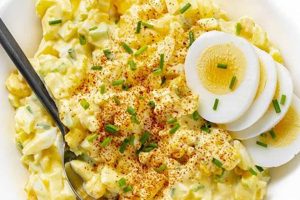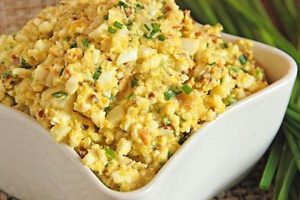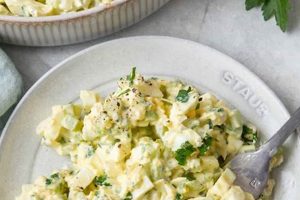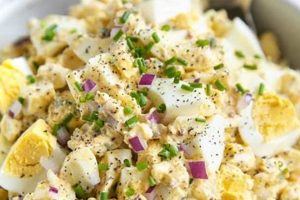A superior tuna salad featuring eggs typically combines high-quality canned tuna with hard-boiled eggs, mayonnaise, and a variety of seasonings. Common additions include celery, onion, relish, Dijon mustard, and spices like black pepper or paprika. A well-executed version offers a balance of creamy, savory, and subtly acidic flavors, with textural complexity provided by the tuna flakes and chopped egg.
This classic dish offers a convenient and nutritious meal option. Tuna provides protein and omega-3 fatty acids, while eggs contribute protein and essential vitamins. The customizable nature of the recipe allows for adjustments based on dietary preferences and available ingredients. Historically, combining canned tuna with mayonnaise gained popularity in the early 20th century as canned goods became more readily available and affordable. The addition of eggs further enhances the nutritional value and creates a more substantial meal.
The following sections will explore variations on this culinary staple, offering guidance on ingredient selection, preparation techniques, and creative serving suggestions. From classic combinations to innovative twists, the possibilities for a delicious and satisfying tuna and egg salad are extensive.
Tips for an Exceptional Tuna Salad with Eggs
Elevating tuna salad with eggs from simple to extraordinary involves careful attention to ingredients and techniques. These tips offer guidance for achieving optimal flavor and texture.
Tip 1: Quality Ingredients Matter: Opt for high-quality canned tuna packed in water or oil, depending on preference. Freshly squeezed lemon juice enhances brightness, while farm-fresh eggs contribute richer flavor.
Tip 2: Precise Egg Cooking: Achieving perfectly cooked hard-boiled eggs is crucial. Overcooked yolks become dry and crumbly. Aim for a firm, yet creamy yolk by cooking for 8-10 minutes, followed by an immediate ice bath.
Tip 3: Mayonnaise Mastery: Mayonnaise serves as the foundation of the salad’s creaminess. Experiment with different types, such as olive oil-based or avocado oil mayonnaise, to find a preferred flavor profile. Start with a small amount and add more as needed to prevent an overly rich result.
Tip 4: Texture Enhancement: Finely diced celery and red onion offer a crisp counterpoint to the creamy base. Consider incorporating chopped pickles, capers, or water chestnuts for added textural complexity.
Tip 5: Seasoning Strategies: Freshly ground black pepper, a pinch of paprika, and a dash of Dijon mustard enhance the savory notes of the tuna. A touch of cayenne pepper adds a subtle kick.
Tip 6: Chilling for Optimal Flavor: Allowing the salad to chill for at least 30 minutes allows the flavors to meld and develop depth. This step is particularly important if using freshly chopped onions or other pungent ingredients.
Tip 7: Creative Serving Suggestions: Beyond the classic sandwich, consider serving the salad on lettuce cups, crackers, or as a filling for stuffed avocados or tomatoes.
By following these guidelines, one can create a tuna salad with eggs that surpasses expectations, offering a delightful balance of flavor and texture.
From classic preparations to innovative variations, the following section will explore various ways to enjoy this versatile dish.
1. High-quality Tuna
Tuna quality significantly impacts the overall success of a tuna salad featuring eggs. Selecting premium tuna elevates the dish from mediocre to exceptional, influencing flavor, texture, and nutritional value. Understanding the nuances of tuna selection is essential for crafting a truly superior salad.
- Species and Processing:
Different tuna species possess distinct flavor profiles and textures. Albacore, known for its delicate flavor and firm texture, is often considered a premium choice. Skipjack, with its stronger flavor and softer texture, offers a more budget-friendly option. Processing methods also play a crucial role. Solid or chunk light tuna typically comprises smaller pieces, while albacore often comes in larger, more intact chunks. The choice between tuna packed in water or oil depends on personal preference and the desired richness of the salad. Water-packed tuna offers a leaner option, while oil-packed tuna contributes a richer flavor and moister texture.
- Freshness Indicators:
Regardless of species or processing, freshness remains paramount. When selecting canned tuna, check the expiration date and examine the can for any signs of damage. Upon opening, the tuna should exhibit a clean, fresh aroma and a firm, consistent texture. Avoid tuna that appears mushy, discolored, or has a strong, fishy odor. These characteristics can negatively impact the final taste and quality of the salad.
- Nutritional Considerations:
Tuna is a good source of protein and omega-3 fatty acids. Opting for tuna packed in water reduces overall fat content compared to oil-packed varieties. Choosing sustainable and responsibly sourced tuna contributes to ocean conservation efforts. Incorporating high-quality tuna into a salad with eggs further enhances the nutritional value of the dish by combining the benefits of both protein sources.
- Impact on Flavor and Texture:
High-quality tuna provides a clean, delicate flavor that allows other ingredients, such as eggs, mayonnaise, and seasonings, to shine. The texture of the tuna also contributes to the overall enjoyment of the salad. Firm, intact chunks of tuna create a more satisfying mouthfeel compared to smaller, fragmented pieces. Selecting premium tuna ensures a pleasant textural experience, complementing the other components of the salad.
By prioritizing high-quality tuna, one establishes a strong foundation for a truly exceptional tuna salad. The interplay between tuna quality and the other ingredients, like eggs and seasonings, culminates in a balanced and flavorful dish. Careful attention to tuna selection elevates the culinary experience, transforming a simple salad into a satisfying and nutritious meal.
2. Perfectly Cooked Eggs
The hallmark of a premium tuna salad often includes perfectly cooked eggs, contributing not only to the nutritional value but also to the texture and overall appeal. Egg preparation significantly influences the final product, impacting the balance of flavors and the enjoyment of each bite. A thorough understanding of optimal egg cooking techniques is essential for creating a truly exceptional tuna salad.
- Timing and Technique:
Precise timing and appropriate cooking methods are crucial for achieving the desired egg consistency. Overcooked yolks become dry, crumbly, and chalky, detracting from the creamy texture essential for a superior tuna salad. Conversely, undercooked yolks create an unappetizing, runny consistency. A cooking time of 8-10 minutes in boiling water, followed by an immediate ice bath, typically yields firm yet creamy yolksideal for tuna salad. Alternative methods, such as steaming or baking, offer greater control over the cooking process and can further refine the texture and flavor of the eggs.
- Visual and Textural Cues:
Recognizing the visual and textural cues of a perfectly cooked egg simplifies the process. The yolk should be fully set but retain a vibrant yellow color and a smooth, creamy texture. The white should be firm and opaque, without any translucent areas. A gentle press on the yolk should yield slight resistance, indicating a properly cooked interior without dryness or crumbliness. These indicators ensure a pleasant textural contrast within the tuna salad, complementing the flaky tuna and creamy mayonnaise.
- Flavor Enhancement:
Properly cooked eggs enhance the overall flavor profile of the tuna salad. The subtly rich flavor of the yolk complements the savory notes of the tuna, while the egg white provides a neutral backdrop that allows other ingredients, such as seasonings and vegetables, to shine. Overcooked eggs can develop a slightly sulfuric odor and flavor, negatively impacting the delicate balance of the salad. Precise cooking preserves the natural flavors of the eggs, allowing them to harmonize with the other components.
- Integration with Other Ingredients:
The consistency of the cooked egg influences how well it integrates with the other ingredients in the salad. Properly cooked eggs, when chopped or diced, maintain their shape and distribute evenly throughout the mixture. Overcooked yolks tend to crumble excessively, creating an uneven texture and potentially overpowering the other flavors. Achieving the correct consistency ensures a harmonious blend of ingredients, where the egg complements the tuna and other components without dominating the flavor or texture.
The careful preparation of eggs significantly impacts the overall quality and enjoyment of tuna salad. From timing and technique to visual cues and flavor integration, each aspect plays a crucial role in achieving a balanced and delicious final product. By mastering the art of perfectly cooked eggs, one elevates this classic dish, transforming it into a truly exceptional culinary experience. Attention to detail in egg preparation ensures a tuna salad that satisfies both the palate and the eye.
3. Balanced Flavor Profile
A balanced flavor profile is paramount in achieving a superior tuna salad incorporating eggs. This balance hinges on the harmonious interplay of key taste elements: savoriness from the tuna, richness from the mayonnaise and egg yolks, acidity to cut through the richness, and subtle sweetness and hints of spice for complexity. A well-balanced salad avoids any single flavor dominating, resulting in a more nuanced and enjoyable experience. For instance, excessive mayonnaise can overwhelm the delicate tuna flavor, while insufficient acidity can render the salad overly rich. A successful recipe carefully calibrates these elements, ensuring a harmonious blend.
Achieving this balance necessitates careful consideration of ingredient quality and proportions. High-quality tuna, packed in water rather than oil, contributes a cleaner flavor, allowing other components to shine. Freshly squeezed lemon juice offers a brighter acidity than bottled varieties, enhancing the overall freshness. The judicious use of seasonings, such as Dijon mustard for tang, black pepper for subtle heat, and a touch of sugar or honey to balance the acidity, further refines the flavor profile. Fresh herbs, like dill or chives, can introduce another layer of complexity. Ultimately, the “best” designation relies on this intricate balance, ensuring that each ingredient contributes to the overall harmony without overpowering others. A practical application of this understanding involves tasting and adjusting throughout the preparation process, adding a pinch of salt, a squeeze of lemon, or a dash of spice as needed to achieve the desired equilibrium.
Mastery of a balanced flavor profile distinguishes a truly exceptional tuna salad with eggs from a merely adequate one. It requires an understanding of how individual ingredients interact and contribute to the overall taste experience. The pursuit of this balance, achieved through careful ingredient selection, precise proportions, and thoughtful seasoning, ultimately defines culinary excellence in this classic dish. The ability to adapt and adjust based on specific ingredient characteristics further underscores the importance of a nuanced understanding of flavor dynamics.
4. Optimal Mayonnaise-to-Tuna Ratio
The mayonnaise-to-tuna ratio significantly influences the final quality of tuna salad incorporating eggs. This ratio determines the overall texture, moisture level, and how well the flavors meld. Too much mayonnaise results in a gloppy, overly rich salad where the tuna flavor becomes diluted. Conversely, too little mayonnaise leads to a dry, crumbly texture lacking the creamy consistency characteristic of a well-made tuna salad. The optimal ratio allows the flavors of the tuna, eggs, and other ingredients to shine while providing the desired smooth, creamy texture. This balance is crucial for a satisfying sensory experience.
Consider a scenario where two identical batches of tuna salad are prepared, differing only in the amount of mayonnaise. The batch with excessive mayonnaise might appear visually appealing at first, boasting a glossy sheen and smooth texture. However, upon tasting, the dominant flavor will be of mayonnaise, masking the subtle nuances of the tuna and other ingredients. The texture may also be excessively slick, lacking textural contrast. In contrast, the batch with the optimal mayonnaise-to-tuna ratio will showcase the flavors of the tuna and eggs, complemented by the creamy texture of the mayonnaise without being overwhelmed by it. The texture will be smooth yet retain some of the tuna’s natural flakiness, offering a more balanced and enjoyable mouthfeel. This comparison illustrates the practical significance of achieving the correct balance.
Achieving the optimal mayonnaise-to-tuna ratio often involves a degree of experimentation and personal preference. However, a general guideline suggests starting with a ratio of approximately 1:2, mayonnaise to tuna, and adjusting based on the specific ingredients and desired consistency. Factors such as the moisture content of the tuna (water-packed versus oil-packed) and the addition of other ingredients, such as chopped vegetables, can influence the optimal ratio. Careful observation and adjustment during preparation are crucial. Adding mayonnaise incrementally allows for better control over the final texture and flavor, ensuring a harmonious blend of ingredients and a truly exceptional tuna salad. Understanding this principle allows for consistent results and elevates the dish beyond basic to exceptional.
5. Fresh, Crisp Add-ins
Fresh, crisp add-ins play a vital role in elevating tuna salad with eggs beyond the ordinary. These elements contribute textural contrast and introduce a refreshing dimension that complements the richness of the mayonnaise and the savory notes of the tuna and eggs. Strategic incorporation of such ingredients elevates both the sensory experience and the nutritional value of the final dish.
- Textural Variety:
Tuna salad, comprised primarily of soft ingredients like tuna, eggs, and mayonnaise, benefits significantly from the incorporation of contrasting textures. Fresh, crisp add-ins, such as finely diced celery, red onion, or bell peppers, provide a satisfying crunch that enhances the overall enjoyment. This textural complexity prevents the salad from feeling monotonous and adds a refreshing element to each bite. Imagine the difference between a smooth, homogenous puree and a salad incorporating crunchy vegetables; the latter offers a more dynamic and engaging experience.
- Flavor Enhancement:
Beyond textural contrast, fresh add-ins contribute nuanced flavors that complement the core ingredients. Celery imparts a subtle, slightly bitter note that balances the richness of the mayonnaise. Red onion introduces a sharp, pungent bite, while bell peppers offer a mild sweetness. These complementary flavors create a more complex and interesting flavor profile, preventing the salad from tasting bland or one-dimensional. The careful selection of add-ins can tailor the flavor profile to individual preferences, allowing for customized variations.
- Nutritional Value:
Incorporating fresh vegetables increases the nutritional value of tuna salad. Ingredients like celery, red onion, and bell peppers are rich in vitamins, minerals, and antioxidants, contributing to a more healthful and balanced meal. This nutritional boost elevates tuna salad from a simple protein source to a dish packed with essential nutrients. Consider the added benefit of incorporating ingredients like chopped water chestnuts, which offer a unique crunch and contribute dietary fiber.
- Visual Appeal:
Fresh, crisp add-ins enhance the visual appeal of tuna salad, transforming it from a homogenous mixture to a more vibrant and appetizing dish. The bright colors of ingredients like red onion, bell peppers, or chopped fresh herbs create visual interest and stimulate the appetite. This visual enhancement makes the salad more appealing, encouraging consumption and enhancing the overall dining experience. A thoughtfully composed salad, with its variety of colors and textures, is more inviting than a plain, unadorned mixture.
The strategic inclusion of fresh, crisp add-ins elevates tuna salad with eggs from a simple staple to a more complex and satisfying culinary creation. The interplay of textures, flavors, nutritional benefits, and visual appeal contributes to a more enjoyable and healthful meal. These elements, when thoughtfully combined, demonstrate the potential of simple ingredients to create a truly exceptional dish.
6. Appropriate Seasonings
Seasoning is a critical factor differentiating a standard tuna salad with eggs from an exceptional one. The considered application of spices and flavor enhancers elevates the inherent flavors of the core ingredientstuna, eggs, and mayonnaisecreating a more complex and satisfying culinary experience. A bland tuna salad, even with high-quality ingredients, can be underwhelming. Conversely, the judicious use of seasonings transforms the dish, adding depth and complexity.
- Balancing Salt and Pepper:
The foundation of any well-seasoned dish lies in the balance of salt and pepper. In tuna salad, salt enhances the savory notes of the tuna while pepper adds a subtle bite. However, over-salting can mask the delicate flavors of the other ingredients, while excessive pepper can create an unpleasant heat. Achieving the correct balance is crucial. A practical approach involves seasoning incrementally, tasting frequently, and adjusting as needed. This ensures the seasonings enhance rather than overpower the other flavors.
- Acidity and Brightness:
Acidity plays a crucial role in balancing the richness of the mayonnaise and egg yolks. A squeeze of fresh lemon juice or a dash of vinegar brightens the flavor profile, preventing the salad from tasting overly heavy. The acidity also complements the savory notes of the tuna, creating a more well-rounded flavor experience. Different types of vinegar, such as apple cider or white wine vinegar, offer subtle flavor variations, allowing for customization.
- Aromatic Complexity:
Aromatic seasonings add depth and complexity to tuna salad. A pinch of paprika contributes a subtle smokiness, while a dash of onion powder or garlic powder enhances the savory notes. Fresh herbs, such as dill, chives, or parsley, introduce a fresh, herbaceous element. These aromatic additions create a more nuanced flavor profile, elevating the salad beyond the basic flavors of the core ingredients. Experimenting with different combinations of herbs and spices allows for personalized flavor profiles.
- Enhancing Savory Notes:
Ingredients like Dijon mustard, Worcestershire sauce, or hot sauce enhance the savory notes of the tuna and add a touch of umami. Dijon mustard contributes a tangy complexity, while Worcestershire sauce provides a depth of flavor derived from fermented ingredients. Hot sauce introduces a spicy kick, customizable to individual preferences. These additions create a more layered and satisfying savory experience, preventing the salad from tasting bland or one-dimensional.
The careful selection and application of seasonings distinguish a truly exceptional tuna salad with eggs. The interplay of salt, pepper, acidity, aromatics, and savory enhancers creates a harmonious flavor profile that elevates the dish beyond the sum of its parts. Understanding the role of each seasoning component allows for informed choices, resulting in a customized and delicious culinary experience. This attention to detail transforms a simple tuna salad into a nuanced and satisfying meal.
Frequently Asked Questions
This section addresses common inquiries regarding the preparation and enjoyment of tuna salad with eggs, offering practical guidance for achieving optimal results.
Question 1: What type of tuna is best suited for tuna salad?
Albacore tuna, known for its firm texture and mild flavor, is often preferred. Skipjack offers a more budget-friendly option with a stronger flavor. Ultimately, the choice depends on individual preferences.
Question 2: How can one prevent hard-boiled eggs from becoming overcooked and rubbery?
An ice bath immediately after boiling halts the cooking process and helps maintain a creamy yolk. Precise timing, typically 8-10 minutes, is also crucial.
Question 3: What can be used as a substitute for mayonnaise?
Plain Greek yogurt or avocado offer healthier alternatives to mayonnaise, contributing creaminess while reducing overall fat content. These substitutions may subtly alter the flavor profile.
Question 4: How can one prevent tuna salad from becoming too watery?
Thoroughly draining the tuna and ensuring the vegetables are dry before incorporating them helps minimize excess moisture. Using water-packed tuna also contributes to a drier salad.
Question 5: How long can tuna salad be stored in the refrigerator?
Tuna salad, when stored in an airtight container in the refrigerator, typically remains safe to consume for up to 3-5 days. However, consuming it within the first 2 days is recommended for optimal flavor and quality.
Question 6: How can one enhance the flavor of tuna salad beyond the basic ingredients?
Fresh herbs, such as dill or chives, add a bright, herbaceous element. Spices like paprika or cayenne pepper introduce complexity. A dash of Dijon mustard or a squeeze of lemon juice provides a tangy counterpoint to the richness.
By understanding these fundamental aspects of preparation and storage, one can consistently create a delicious and satisfying tuna salad experience.
The following section will offer creative serving suggestions and variations on the classic tuna salad recipe, further expanding the culinary possibilities.
Conclusion
Crafting a superior tuna salad featuring eggs hinges on a confluence of factors, each contributing to the overall quality and enjoyment of the dish. Ingredient selection, including premium tuna and fresh produce, forms the foundation. Precise cooking techniques, particularly for the eggs, ensure optimal texture and flavor. The careful balance of mayonnaise, seasonings, and add-ins elevates the salad beyond a simple combination of ingredients, creating a harmonious blend of creamy, savory, and crisp elements. Understanding the interplay of these components allows for informed choices, empowering culinary creativity and ensuring a consistently satisfying result.
The pursuit of the “best” tuna salad recipe with eggs remains a subjective endeavor, influenced by individual preferences and culinary traditions. However, the principles outlined herein offer a framework for achieving excellence in this classic dish. Continued exploration of ingredient variations, flavor combinations, and presentation styles promises a perpetually evolving culinary landscape, ensuring that the humble tuna salad remains a timeless and adaptable culinary staple.






